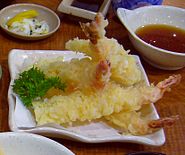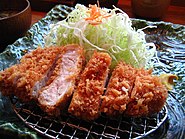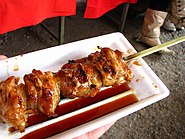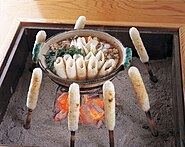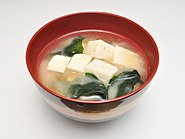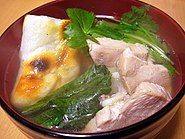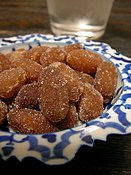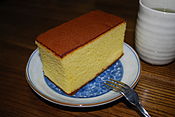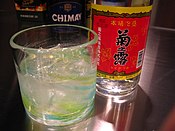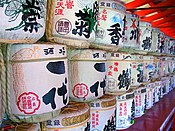List of Japanese dishes
This article needs additional citations for verification. (December 2012) |
 |
| This article is part of the series |
| Japanese cuisine 日本料理 |
|---|
|
|


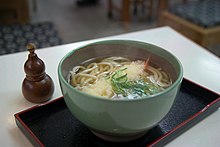
Below is a list of dishes found in Japanese cuisine. Apart from rice, staples in
Rice dishes (ご飯物)
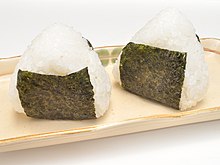
- Gohan or meshi: plainly cooked white rice. It is such a staple that the terms gohan and meshi are also used to refer to meals in general, such as Asa gohan/meshi (朝御飯, 朝飯, breakfast), Hiru gohan/meshi (昼御飯, 昼飯, lunch), and Ban gohan/meshi (晩御飯, 晩飯, dinner). Also, raw rice is called kome (米, rice), while cooked rice is gohan (ご飯, [cooked] rice). Nori (海苔), and furikake (ふりかけ) are popular condiments in Japanese breakfast. Some alternatives are:
- Curry rice (karē raisu カレーライス): Introduced from the UK in the late 19th century, "curry rice" is now one of the most popular dishes in Japan. It is much milder than its Indian counterpart.
- Chāhan (炒飯) or yakimeshi (焼飯): fried rice, adapted to Japanese tastes, tends to be lighter in flavor and style than the Chinese version from which it is derived
- Genmai gohan (玄米御飯): brown rice
- Hayashi rice (ハヤシライス): thick beef stew on rice
- Kamameshi (釜飯): rice topped with vegetables and chicken or seafood, then baked in an individual-sized pot
- peasant food consisting of rice, barley, millet and chopped daikon radish[1]
- Mochi(餅): glutinous rice cake
- Mugi gohan/Mugi meshi (麦御飯, 麦飯): white rice cooked with barley
- Ochazuke (御茶漬け): hot green tea or dashi (出汁) poured over cooked white rice, often with various savory ingredients such as umeboshi (梅干) or tsukemono(漬物).
- Okowa (おこわ): cooked glutinous rice
- Tōkyō
- Onigiri (おにぎり): balls of rice with a filling in the middle. Japanese equivalent of sandwiches.
- . (literally red rice)
- Takikomi gohan (炊き込み御飯): Japanese-style pilaf cooked with various ingredients and flavored with soy, dashi, etc.
- Tamago kake gohan (卵掛け御飯): Rice with a raw egg
- Tenmusu: a rice ball wrapped with nori that is filled with deep-fried tempura shrimp[3]
-
Chāhan
-
Sekihan
Rice porridge (お粥)
- Nanakusa-gayu (七草粥) is the long-standing Japanese custom of eating seven-herb rice porridge (nanakusa-gayu) on January 7 (Jinjitsu).
- and usually served to infants and sick people.
- Zosui (Zōsui, 雑炊) or Ojiya (おじや) is a soup containing rice stewed in stock, often with egg, meat, seafood, vegetables or mushroom, and flavored with miso or soy. Known as juushii in Okinawa. Some similarity to risotto and Kayu though Zosui uses cooked rice, as the difference is that kayu is made from raw rice.
Rice bowls (どんぶり)
A one-bowl dish, consisting of a
- Gyūdon: (牛丼, beef bowl): Donburi topped with seasoned beef and onion
- chicken(chickendon)
- Oyakodon (親子丼): Donburi topped with chicken and egg (or sometimes salmon and salmon roe) (literally Parent and Child bowl)
- Tekkadon (鉄火丼): Donburi topped with tuna sashimi
- Tendon: (天丼): Donburi topped with tempura(battered shrimp and vegetables)
- Unadon: (うな丼, 鰻丼): Donburi topped with broiled eel with vegetables
- Wappameshi: (わっぱ飯): rice topped with other ingredients, cooked in wooden containers called wappa
Sushi (寿司)

Sushi (寿司, 鮨, 鮓) is a vinegared rice topped or mixed with various fresh ingredients, usually seafood or vegetables.
- Nigirizushi (握り寿司): Sushi with the ingredients on top of a block of rice.
- Makizushi (巻き寿司): Translated as "roll sushi". Seasoned rice and seafood or other ingredients are placed on a sheet of seaweed (nori, dried laver) and rolled into a cylindrical shape, then sliced into smaller rounds. Typical ingredients are Tamagoyaki (Japanese-style omelette), simmered shiitake mushroom, boiled prawn and cucumber.[4]
- makizushi, except that the noriis rolled into a cone-shape with the ingredients placed inside. Sometimes referred to as a "hand-roll".
- Chirashizushi(ちらし寿司) or Bara-zushi (バラ寿司): Translated as "scattered", chirashi involves fresh seafood, vegetables or other ingredients being placed on top of sushi rice in a bowl or dish.
- Inarizushi(稲荷寿司, お稲荷さん): Fried tofu packet braised in sweet soy sauce stuffed with sushi rice (no fillings)
- Oshizushi(押し寿司): A pressed sushi using cured or cooked fish, most commonly mackerel.
- Sumeshi wrapped in Takana leaves. Unique to Wakayama Prefecture.
Other staples
Noodles (men-rui, 麺類)
- Traditional Japanese noodles are usually served chilled with a dipping sauce, or in a hot soy-dashi broth.
- Okinawa, soba likely refers to Okinawa soba (see below).
- Zaru soba (ざるそば): Soba noodles served cold
- Udon (うどん): thick white wheat noodles served with various toppings, usually in a hot soy-dashi broth, or sometimes in a Japanese curry soup.
- Miso-nikomi-Udon (味噌煮込みうどん): hard udon simmered in red miso soup.
- Sōmen (素麺, そうめん): thin white wheat noodles served chilled with a dipping sauce. Hot sōmen is called Nyumen.

- Chinese-influenced noodles are served in a meat or chicken broth and have only appeared in the last 100 years or so.
- Ramen (ラーメン): thin light yellow noodles served in hot chicken or pork broth with various toppings; of Chinese origin, it is a popular and common item in Japan. Also known as Shina-soba (支那そば) or Chūka-soba (中華そば) (both mean "Chinese-style soba").
- Nagasakias a cheap food for students.
- Hiyashi chūka (冷やし中華): thin, yellow noodles served cold with a variety of toppings, such as cucumber, tomato, ham or chicken, bean sprouts, thin-sliced omelet, etc., and a cold sauce (soy sauce based, sesame based, etc.). The name means "cold Chinese noodles."
- Mazesoba (まぜそば: wheat noodles served with a number of savory toppings, including raw egg, ginger, and meat
- Okinawa, often served in a hot broth with sōki, steamed pork. Akin to a cross between udon and ramen.
- Yaki soba(焼きそば): Fried Chinese noodles.
- Yaki udon (焼きうどん): Fried udon noodles.
Bread (pan, パン)
Bread (the word "pan" (パン) is derived from the Portuguese pão)[5] is not native to Japan and is not considered traditional Japanese food, but since its introduction in the 16th century it has become common.
- Curry bread (karē pan カレーパン): deep fried bread filled with Japanese curry sauce[6]
- Anpan (ampan アンパン): sweet roll filled with red bean (anko) paste
- Yakisoba-pan (焼きそばパン): bread roll sandwich with yakisoba (fried noodles and red pickled ginger) filling
- Korokke-pan (コロッケパン): bread roll sandwich with croquette (deep-fried patties mashed potato) filling
- Melon-pan (メロンパン): sweet round bun covered in a (sometimes melon flavored) cookie-like coating, scored in criss cross shape and baked
- Katsu-sando (カツサンド): sandwich with tonkatsu (breaded pork cutlet) filling
-
Breaded cutlet-sandwich (カツサンド)
Common Japanese main and side dishes (okazu, おかず)
- side dishes
Deep-fried dishes (agemono, 揚げ物)
- Agemono (揚げ物): Deep-fried dishes
- Karaage (唐揚げ): bite-sized pieces of chicken, fish, octopus, or other meat, floured and deep fried. Common izakaya (居酒屋) food, also often available in convenience stores.
- Nanbanzuke (南蛮漬け): marinated fried fish.
- Korokke (croquette コロッケ): breaded and deep-fried patties, containing either mashed potato or white sauce mixed with minced meat, vegetables or seafood. Popular everyday food.
- Kushikatsu (串カツ): skewered meat, vegetables or seafood, breaded and deep fried.
- Satsuma-age (薩摩揚げ): fried fishcake (surimi), often used as an ingredient for oden.
- Tempura (天ぷら): deep-fried vegetables or seafood in a light, distinctive batter.
- Kakiage (かき揚げ)
- Tonkatsu (豚カツ): deep-fried breaded cutlet of pork (chicken versions are called chicken katsu).
- Karaage (唐揚げ): bite-sized pieces of chicken, fish, octopus, or other meat, floured and deep fried. Common izakaya (居酒屋) food, also often available in convenience stores.
- Agedashi dōfu (揚げ出し豆腐): cubes of deep-fried silken tofu served in hot broth.
-
Ebi tempura
Grilled and pan-fried dishes (yakimono, 焼き物)

- pan-frieddishes
- dumplings(potstickers), usually filled with pork and vegetables (spring onion, leek, cabbage, garlic, and ginger) and pan-fried
- skewersof meat and vegetables
- Motoyaki (もと焼き): Baked seafood topped with a creamy sauce.[7]
- Okonomiyaki (お好み焼き) are savory pancakes with various meat and vegetable ingredients, flavored with the likes of Worcestershire sauce or mayonnaise.
- Takoyaki (たこ焼き, 蛸焼き): a spherical, fried dumpling of batter with a piece of octopus inside. Popular street snack.
- Teriyaki (照り焼き): grilled, broiled, or pan-fried meat, fish, chicken or vegetables glazed with a sweetened soy sauce
- Unagi (鰻, うなぎ), including kabayaki (蒲焼): grilled and flavored eel
- Yakiniku ("grilled meat" 焼肉) may refer to several things. Vegetables such as bite-sized onion, carrot, cabbage, mushrooms, and bell pepper are usually grilled together. Grilled ingredients are dipped in a sauce known as tare before being eaten.
- Horumonyaki ("offal-grill" ホルモン焼き): similar homegrown dish, but using offal
- Hokkaidō.
- Yakitori (焼き鳥): barbecued chicken skewers, usually served with beer. In Japan, yakitori usually consists of a wide variety of parts of the chicken. It is not usual to see straight chicken meat as the only type of yakitori in a meal.
- Arabesque greenling) are also served this way.
Nabemono (one pot cooking, 鍋物)
Nabemono (鍋物) includes:
- Motsunabe (モツ鍋): beef offal, Chinese cabbage and various vegetables cooked in a light soup base.
- Shabu-shabu (しゃぶしゃぶ): hot pot with thinly sliced beef, vegetables, and tofu, cooked in a thin stock at the table and dipped in a soy or sesame-based dip before eating.
- Sukiyaki (すき焼き): thinly sliced beef and vegetables cooked in a mixture of soy sauce, dashi, sugar, and sake. Participants cook at the table then dip food into their individual bowls of raw egg before eating it.
- Chirinabe (ちり鍋): hot pot with fish and vegetables.
- blowfish and vegetables, a specialty of Osaka.
- .
- Imoni (芋煮): a thick taro potato stew popular in Northern Japan during the autumn season
- Kiritanponabe (きりたんぽ鍋): freshly cooked rice is pounded, formed into cylinders around Japanese cypress skewers, and toasted at an open hearth. The kiritanpo are used as dumplings in soups.
- Chankonabe (ちゃんこ鍋): commonly eaten in vast quantity by sumo wrestlers as part of a weight-gain diet.
-
Sukiyaki (すき焼き)
Nimono (stewed dishes, 煮物)

Nimono (煮物) is a stewed or simmered dish. A base ingredient is simmered in shiru stock flavored with sake, soy sauce, and a small amount of sweetening.
- Oden (おでん, "kantou-daki", 関東炊き): surimi, boiled eggs, daikon radish, konnyaku, and fish cakes stewed in a light, soy-flavored dashi broth. Common wintertime food and often available in convenience stores.
- Kakuni (角煮): chunks of pork belly stewed in soy, mirin and sake with large pieces of daikon and whole boiled eggs. The Okinawan variation, using awamori, soy sauce and miso, is known as Rafute (ラフテー).
- Nikujaga (肉じゃが): beef and potato stew, flavored with sweet soy.
- Nizakana (煮魚): fish poached in sweet soy (often on the menu as nitsuke (煮付け)).
- Sōki (ソーキ): Okinawan dish of pork stewed with bone.
Itamemono (stir-fried dishes, 炒め物)

Stir-frying (炒め物) is not a native method of cooking in Japan, however mock-Chinese stir fries such as yasai itame (野菜炒め, stir fried vegetables) have been a staple in homes and canteens across Japan since the 1950s. Home grown stir fries include:
- gōyāchanpurū.
- Kinpira gobo (金平): Thin sticks of greater burdock (gobo, ゴボウ) and other root vegetables stir-fried and braised in sweetened soy.
Sashimi (刺身)

Sashimi (刺身) is raw, thinly sliced foods served with a dipping sauce and simple garnishes; usually fish or shellfish served with soy sauce and wasabi. Less common variations include:
- pufferfish(sometimes lethal), a uniquely Japanese specialty. The chef responsible for preparing it must be licensed.
- Ikizukuri (活き造り): live sashimi
- Tataki (たたき): raw/very rare skipjack tuna or beef steak seared on the outside and sliced, or a finely chopped raw fish (Japanese jack mackerel or Sardine), spiced with the likes of chopped spring onions, ginger or garlic paste.
- Shinshu(Nagano, Gifu and Toyama prefectures) and Kumamoto. Basashi features on the menu of many izakayas, even on the menus of big national chains.
- Torisashi (鶏刺し): chicken breast sashimi, regional specialty of Kagoshima, Miyazaki prefectures
- Rebasashi (レバ刺し) is typically liver of calf served completely raw (the rare version is called "aburi": あぶり). It is usually dipped in salted sesame oil rather than soy sauce.
Soups (suimono (吸い物) and shirumono (汁物))
The
- Miso soup (味噌汁): soup made with miso suspended in dashi, usually containing two or three types of solid ingredients, such as seaweed, vegetables or tofu.
- Tonjiru (豚汁): similar to miso soup, except that pork is added to the ingredients
- Dangojiru (団子汁): soup made with dumplings along with seaweed, tofu, lotus root, or any number of other vegetables and roots
- Sumashijiru (澄まし汁) or "osumashi" (お澄まし): a clear soup made with dashi and seafood or chicken.
- mochi rice cakes along with various vegetables and often chicken. It is usually eaten at New Years Day.
-
Miso soup (味噌汁)
Pickled or salted foods (tsukemono, 漬け物)
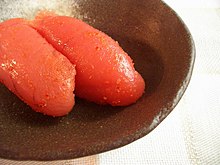
These foods are usually served in tiny portions, as a side dish to be eaten with white rice, to accompany sake or as a topping for rice porridges.
- .
-
- viscera
- Tsukemono (漬物): pickled vegetables, hundreds of varieties and served with most rice-based meals
- .
- Tsukudani (佃煮): Very small fish, shellfish or seaweed stewed in sweetened soy for preservation
-
Umeboshi (梅干)
Side dishes (惣菜)

- Bento or Obento (弁当, 御弁当) is a combination meal served in a wooden box, usually as a cold lunchbox.
- Chawan mushi(茶碗蒸し) is meat (seafood and/or chicken) and vegetables steamed in egg custard.
- Edamame (枝豆) is boiled and salted pods of soybeans, eaten as a snack, often to accompany beer.
- Himono (干物): dried fish, often aji (Japanese jack mackerel, 鯵). Traditionally served for breakfast with rice, miso soup and pickles.
- Hiyayakko (冷奴): chilled tofu with garnish
- Tōhokubut slowly gaining popularity in other regions in which nattō was not as popular
- boiled greenssuch as spinach, chilled and flavored with soy sauce, often with garnish
- Osechi (御節): traditional foods eaten at New Year
- Japanese salad dressings
- Wafu dressing (和風ドレッシング): literally "Japanese-style dressing" is a vinaigrette-type salad dressing based on soy sauce, popular in Japan.
- Sanbaizu (三杯酢): The so-called vinegar that is blended with the ingredient here is often sanbaizu ("three cupful/spoonful vinegar"),[8] which is a blend of vinegar, mirin, and soy sauce.
- Shimotsukare (しもつかれ): made of vegetables, soybeans, abura-age (あぶらあげ or deep fried tofu skins) and sake kasu (酒粕, rice pulp from fermented sake).
Chinmi (珍味)

Chinmi (珍味) are regional delicacies, and include:
- Ankimo (あん肝)
- Karasumi (カラスミ)
- Konowata (このわた)
- Mozuku (モズク)
- Uni (ウニ): specifically, salt-pickled sea urchin
Although most Japanese eschew eating insects, in some regions,
Sweets and snacks (okashi (おかし), oyatsu (おやつ))
- Okashi (おかし), Oyatsu (おやつ): Sweets and snacks
Japanese-style sweets (wagashi, 和菓子)
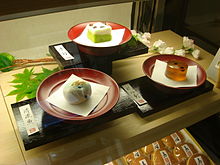
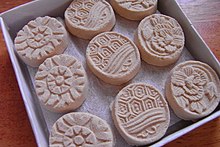
Wagashi include:
- Amanattō: traditional confectionery made of adzuki or other beans, covered with refined sugar after simmering with sugar syrup and drying.
- Dango: a Japanese dumpling and sweet made from mochiko (rice flour),[1][citation not found] related to mochi.
- Hanabiramochi: a Japanese sweet (wagashi), usually eaten at the beginning of the year.
- Higashi: a type of wagashi, which is dry and contains very little moisture, and thus keeps relatively longer than other kinds of wagashi.
- Hoshigaki: dried persimmon fruit.
- Imagawayaki: also known as Taikoyaki, is a round Taiyaki and fillings are same.
- Kakigōri: shaved ice with syrup topping.
- Kompeito: crystal sugar candy.
- sticky ricesurrounding a sweet bean center.
- Matsunoyuki: a wagashi that resembles a pine tree dusted with snow.
- Mochi: steamed sweet rice pounded into a solid, sticky, and somewhat translucent mass.
- mochi: rice cake.
- Uirō: a steamed cake made of rice flour.
- Taiyaki: a fried, fish-shaped cake, usually with a sweet filling such as a red bean paste.
- Namagashi: a type of wagashi, which is a general term for snacks used in the Japanese tea ceremony.
Old-fashioned Japanese-style sweets (dagashi, 駄菓子)
Dagashi include:
- Karume-yaki: Brown sugar cake that is also called "baked caramel".
- Sōsu senbei: Thin Senbei (rice crackers) eaten with brown sauce.
- Mizuame: Sticky liquid sugar candy.
Western-style sweets (yōgashi, 洋菓子)
Yōgashi are Western-style sweets, but in Japan are typically very light or spongy.
- Kasutera: "Castella" Iberian-style sponge cake
- Mirukurepu: "mille feuilles": a layered crepe that literally means "one thousand leaves" in French.
Sweets bread (kashi pan, 菓子パン)
Kashi pan include:
- Anpan: bread with sweet bean paste in the center
- Melonpan: a large, round bun which is a combination of regular dough beneath cookie dough. It occasionally contains a melon-flavored cream, though traditionally it is called melon bread because of its general shape resembling that of a melon (not due to any melon flavor).
-
Peanut amanattō
Other snacks

Snacks include:
- Azuki Ice - vanilla flavored ice cream with sweet azuki beans
- Koara no māchi
- Umai Bō- puffed corn food with various flavors
- Pocky
- Hello Panda
- Hi-chew
- Ice cream - usual flavors such as vanilla and chocolate are the most common. Distinctly Japanese ones include Matcha Ice (green tea ice cream), less common ones include Goma (black sesame seed) and sweet potato flavors.
Tea and other drinks
Tea and non-alcoholic beverages

- Amazake
- Genmaicha is green tea combined with roasted brown rice.
- Gyokuro: Gyokuro leaves are shaded from direct sunlight for approximately 3 weeks before the spring harvest. Removing direct sunlight in this way enhances the proportions of flavonols, amino acids, sugars, and other substances that provide tea aroma and taste. After harvesting the leaves are rolled and dried naturally. Gyokuro is slightly sweeter than sencha and is famous for its crisp, clean taste. Major growing areas include Uji, Kyōto and Shizuoka prefecture.
- Hōjicha: green tea roasted over charcoal
- Konbu-cha: specifically the tea poured with Kombu giving rich flavor in monosodium glutamate.
- Kukicha is a blend of green tea made of stems, stalks, and twigs.
- Kuzuyu is a thick herbal tea made with kudzustarch.
- Matcha is powdered green tea. (Green tea ice cream is flavored with matcha, not ocha.)
- Mugichais barley tea, served chilled during summer.
- Sakurayu is an herbal tea made with pickled cherry blossoms.
- Sencha is steam treated green tea leaves that are then dried.
- Umecha is a tea drink with umeboshi, which provides a refreshing sourness.
- Kuwacha is a noncaffeinated tea made with white mulberryleaves.
Soft drinks
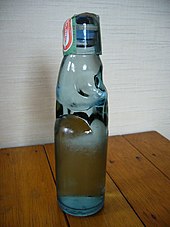
- Calpis
- C.C. Lemon
- Mitsuya Cider
- Oronamin C Drink
- Pocari Sweat
- Qoo
- Ramune
- Yakult
Alcoholic beverages
- Awamori (泡盛)
- Sake (酒, 日本酒)
- Shōchū (焼酎)
- Umeshu (梅酒)
- Kirin
- Japanese whisky - Suntory and Nikka Whisky Distilling are the leading distilleries
-
Okinawa, Japan.
-
Barrels of sake, a traditional Japanese alcoholic drink, on display as an offering at an Itsukushima Shrine
Imported and adapted foods
Japan has incorporated imported food from across the world (mostly from
Foods imported from Portugal in the 16th century
- Kasutera — sponge cake, originating in Nagasaki.
- Konpeitō — star shaped sugar candy, the name comes from the Portuguese word confeito (comfit).
- panko, have been popularized by cooking shows.
- washoku(和食, native food).
Yōshoku
Yōshoku (洋食) is a style of Western-influenced food.
- Breaded seafood or vegetables (furai, フライ, derived from "fry"), and breaded meat (katsuretsu, カツレツ, derived from "cutlet" and often contracted to katsu), are usually served with shredded cabbage and/or lettuce, Japanese Worcestershire or tonkatsu sauce and lemon. Tempura, a related dish, has been heavily modified since its introduction to Japan by use of batter and dashi-flavored dip, and is usually considered to be washoku.
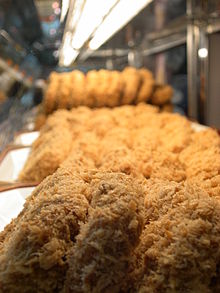
- Kaki furai (カキフライ, 牡蠣フライ) - breaded oyster
- Ebi furai(エビフライ, 海老フライ) - breaded shrimp
- Korokke ("croquette" コロッケ) - breaded mashed potato and minced meat patties. When white sauce is added, it is called cream korokke. Other ingredients such as crab meat, shrimp, or mushrooms are also used instead of minced meat which are called kani-, ebi-, or kinoko-cream korokke, respectively.
- Menchi katsu, chicken katsu, beef katsu, kujira katsu - breaded and deep-fried pork, minced meat patties, chicken, beef, and whale, respectively.
- rakkyo
- Curry Pan - deep fried bread with Japanese curry sauce inside. The pirozhki of Russia was remodeled, and Curry bread was made.
- Curry udon - is a hot noodle dish where the soup is made of Japanese curry and dashi. May also include meat or vegetables.

- Hayashi rice (ハヤシライス) - beef and onions stewed in a red-wine sauce and served on rice
- Nikujaga - soy sauce-flavored meat and potato stew that has been made in Japan to the extent that it is now considered washoku, but again originates from 19th century Japanese Navy chefs adapting beef stews of the Royal Navy.
- Omu raisu - ketchup-flavored rice wrapped in omelet.
Other items were popularized after the war:
- demiglacesauce. Popular post-war food item served at homes. Sometimes eaten with a fork.

- Spaghetti - Japanese versions include:
- with tomato ketchup, wieners, sliced onion and green pepper (called "naporitan" or "napolitan")
- with mentaiko sauce topped with nori seaweed (tarako spaghetti], たらこスパゲッティ) (mentaiko spaghetti, 明太子スパゲッティ)
- with Japanese curry
- Shakey's all operate in Japan, but Japanese brands such as Aoki's and Pizza-Laare higher-grossing and famous for catering to Japanese taste. Many pizza chains offer seasonal toppings. Japanese versions include:
Other homegrown cuisine of foreign origin
- Japanese Americancuisine
- Burgers have various variations in Japan. Domestic chains like MOS Burger and Freshness Burger cater to Japanese tastes with seasonal specials like Teriyaki Burgers and the kinpira rice burger.
- Korean cuisine
- Kimchi from Korea is often served with Japanese Chinese cuisine, though the local variant may use thinner cabbage.
- Japanese Chinese cuisine
- Gyoza[9] are a very popular dish in Japan. Gyoza are the Japanese take on the Chinese dumplingswith rich garlic flavor. Most often, they are seen in the crispy pan-fried form (potstickers), but they can be served boiled or even deep fried, as well.
- Japanese-only "Chinese dishes" like ebi chili(shrimp in a tangy and slightly spicy sauce)
- Mābō dōfutends to be thinner than Chinese mapo doufu.
- Nikuman, anman, butaman and the obscure negi-man are all varieties of mantouwith fillings.
- yaki soba
- Yakisoba-pan is a sandwich with a filling that resembles chow mein noodles.
- Japanese English cuisine
- caramel custard.
Adaptations
- California roll - invented in Canada,[10] then first introduced in California.
- Spam musubi - a snack from Hawaii resembling onigiri, made with Spam
Seasonings
Lots of Japanese foods are prepared using one or more of the following:
- Kombu (kelp), katsuobushi (flakes of cured skipjack tuna, sometimes referred to as bonito) and niboshi (dried baby sardines) are often used to make dashi stock.
- Negi (Chinese chives), rakkyō (Allium chinense) (a type of scallion).
- to dress.
- Shōyu (soy sauce), dashi, mirin, sugar, rice vinegar, miso, sake.
- ).
- A citrus fruit called tonjiru, udon as well as other dishes. Yuzu is also seen to flavor teas, jams or zeri (jelly), and any number of sweets from yuzu-an (a type of bean paste) to yuzu-hachimitsu (yuzu-honey).
Less traditional, but widely used ingredients include:
- glutamate
- Japanese-style Worcestershire sauce, often known as simply "sauce", thicker and fruitier than the original, is commonly used as a table condiment for okonomiyaki (お好み焼き), tonkatsu (トンカツ), croquette ("korokke", コロッケ) and the like.
- Japanese mayonnaise is used with salads, okonomiyaki (お好み焼き), yaki soba (焼きそば) and sometimes mixed with wasabi or soy sauce.
See also
- List of Japanese cooking utensils
- List of Japanese ingredients
- List of Japanese condiments
- List of Japanese desserts and sweets
- List of Japanese soups and stews
References
- ISBN 978-1-86189-298-0. Retrieved June 16, 2017.
- ISBN 978-4-7700-3049-8.
- ISBN 978-981-4484-95-4. Retrieved June 16, 2017.
- ^ "Maki-zushi (Sushi rolls)". NHK. 2011-11-25. Archived from the original on 2017-11-20. Retrieved 2022-06-01.
- ISBN 962-209-572-0.
- ISBN 9781861895226.
- ^ ほたてのレシピ [Recipes for scallops]. 青森県漁業協同組合連合会 (Aomori fishers' cooperations' association) (in Japanese). もと焼き (motoyaki). Archived from the original on 2021-07-20. Retrieved 2021-07-20.
(rough translation) Ingredients of tamagonomoto: 2 egg yolks; 1 tbsp miso; 1 tbsp sugar; salt; pepper
- ISBN 978-1-55832-177-9p.147 "wakame and cucumber in sanbaizu dressing (sunomono)"; p.74 "sanbaizu" recipe
- ^ "Gyoza (Japanese dumplings)". BBC. Retrieved 14 October 2013.
- ^ McInerney, Jay (June 10, 2007). "Raw". The New York Times. Retrieved 14 October 2013.

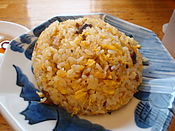
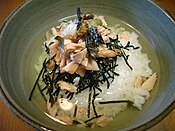
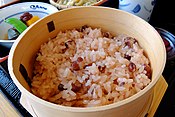

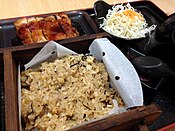
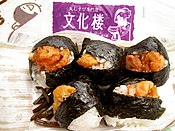

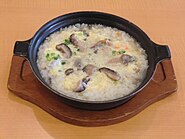




![Breaded cutlet-sandwich [ja] (カツサンド)](http://upload.wikimedia.org/wikipedia/commons/thumb/a/a3/KatsuSando6515.jpg/185px-KatsuSando6515.jpg)


